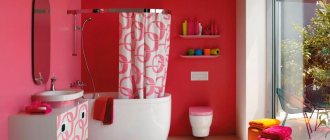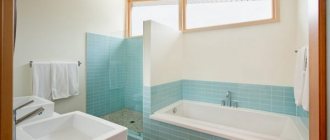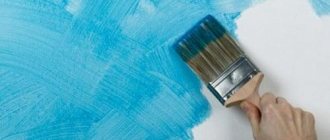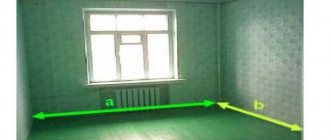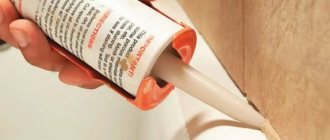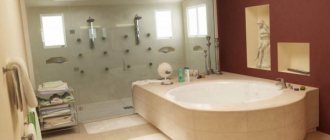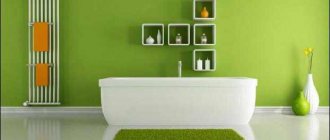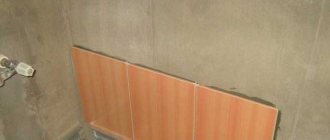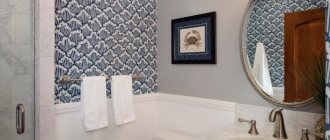The process of repairing wall coverings involves preparing the walls in the bathroom for painting. This stage of repair consists of plastering the walls in the room. Putty is needed so that the paint sticks well to the wall and does not peel or peel. This article will tell you how to choose putty for a bathroom for painting, as well as the process of puttying wall coverings indoors.
The quality of the mixture and its purpose
The putty mixture has a high degree of grain, so it must be thoroughly mixed before starting the application procedure.
And the surface itself, after puttying, is treated with abrasive materials. Due to the fact that the granular consistency of the mixture cannot be eliminated. When painting is applied without treating the plastered surface, all roughness and irregularities will be clearly visible.
A surface treated with putty can be covered with wallpaper, but such treatment is not suitable for a bathroom due to the high exposure to moisture in the room. To simplify the process of applying paint to the wall, manufacturers began to produce fine-grained materials.
The best tool for applying base paint is a spatula. Under the influence of this spatula, you can feel all the imperfections of the wall covering.
It is better for the putty to dry naturally. Artificial drying is not recommended. Rapid drying leads to shrinkage and the appearance of seams or cracks in the coating, which will ruin the appearance even before paint is applied. And you will have to putty the walls in the bathroom again.
Painting walls - step by step instructions
The easiest way is to paint the walls one color. To prevent the product from getting on the ceiling and other surfaces that cannot be painted, they are protected with masking tape.
After this, perform the following steps:
- The paint is mixed until a homogeneous consistency is obtained. The film that appears on the surface is removed, trying to prevent its particles from getting into the composition.
- The finishing material is tinted. Pigment is gradually poured into the container with the water-based solution, stirring the product with a mixer. When the color becomes uniform, add the remaining color. The solution is stirred again. When using oil paints, this step is skipped.
- Paint corners and hard-to-reach places with a narrow brush. The paint is rubbed in, removing stains and drips. The tool must move in one direction.
- Use a roller or wide brush to paint large surfaces. Do not completely immerse the instrument in paint. The roller is rolled out onto a relief tray, removing excess finishing material. The coloring agent is applied in even stripes from top to bottom. Painted walls are allowed to dry for 6-36 hours.
- Carry out the procedure again, after which the masking tape is removed. This stage can be postponed to a later period, but it is advisable to complete it immediately. If the painted walls have stripes or stains, apply a third layer of finishing product.
Types of composition
There are several classifications based on the types of putty mixtures.
According to the degree of readiness, they are distinguished:
- dry solutions;
- ready-made solutions.
In accordance with the purpose, the following are distinguished:
- putty made of polymeric materials;
- cement-based mortars;
- gypsum materials.
Each type has both advantages and disadvantages.
Mixtures for plastering on beacons based on cement are resistant to moisture. The quality of the mixture is not affected by the level of humidity in the room.
We recommend reading: Plaster for the bathroom: what mixture is suitable for a wet room
Experts recommend just such solutions for bathroom renovations. In addition, the price of such a mixture is low, which is an advantage for self-repairs.
But, despite all the advantages, the cement mixture has a significant drawback for beginners in repair - it has a structure with frequent and large grains.
If the owner of the apartment plans to make the room light, then you cannot use such a base for paint, since the dried putty has a gray color.
Another disadvantage of cement material is its tendency to shrink. It must be applied in several layers, and each layer must be processed after drying.
Bathroom putty for painting is also produced on the basis of modern material - polymer . Its advantage is that it produces a polymerization process upon contact with the air, which results in the formation of a perfectly flat surface. This mixture does not dry out for a long time, so the filling process can be delayed.
But there is one drawback - the ability of modern components to cause allergies. Therefore, even if the person carrying out the repairs is not prone to allergies, he should consider protection in the form of a respirator.
Gypsum materials are suitable for light paint colors, as they are presented in light powder.
This type of putty is applied in an even layer and dries quickly. But it has a huge disadvantage - exposure to temperature, so it is not suitable for use in the bathroom.
Decorative painting methods
Not every person has artistic talent, so special tools are used to create unusual designs.
Using stencils
Disposable stencils are made from vinyl and supplied with an adhesive base. Acrylic templates are intended for long-term use.
Painting walls using stencils is done as follows:
- Apply the base tone in the standard way. Choose a pattern and determine its location.
- Remove the protective film of the stencil and apply the template to the wall. If there is no adhesive layer, the instrument is fixed with masking tape.
- Saturate the roller with paint, removing excess. The cutouts are painted evenly. Move the stencil, continuing to create the pattern.
- Remove the template from the wall and let the drawing dry. The color of the ornament must match the background.
Striped walls
To create such a design, perform the following steps:
- Paint the surfaces in a base tone. Starting from the corner, use a building level to draw a vertical line. Determine the width of the strip and draw the next line. In this way, mark all the stripes up to the corner.
- Painting tape is applied along the lines. It should go beyond the boundaries of the stripes of the main color. The previously drawn lines are not covered with tape. After gluing, the tape is smoothed, releasing air.
- Tape the joints between the wall and the ceiling. Dip the roller into the paint and run it along the first stripe. The material should lie evenly, without forming spots or streaks.
- Move to the next strip, observing the order of colors. After the first layer has dried, apply the second.
- Remove the masking tape without making sudden movements.
Rollers for applications
The tool is equipped with 2 attachments: standard foam and textured rubber. To create an ornament, choose a paint of a contrasting shade. The roller is immersed in the composition, soaking the base nozzle with it. The tool is rolled out onto the tray, and the roller is moved along the wall from top to bottom, without moving it to the sides. The next strip is placed parallel to the first.
Types of polymer compositions
Polymer compositions are the newest and most modern type of putty, which is in high demand in the construction market. Among the varieties of such solutions, acrylic and latex mixtures are distinguished.
Both types have a large number of advantages. For example, they are able to organize a perfectly even coating, while at the same time being able to fill in unevenness in the wall.
The advantage of acrylic mixtures over latex ones is that they are odorless and do not cause allergies. In turn, latex compositions are suitable for all types of building materials.
We recommend reading: Photo tiles - material for repairs and creativity
Good paints for bathrooms
Paints that work well in bathrooms have several key characteristics:
- Inhibiting Properties : Bathroom paint contains antimicrobial additives that help resist (but do not completely prevent) mold.
- Washable Finish: Because bathroom walls need to be wiped down or even scrubbed from time to time, a good bathroom paint is a little tougher and more resilient than other interior paints.
- Dense Structure: Some paints have a denser structure, which can cause gloss paints to perform as well as higher gloss paints in high humidity environments.
Material requirements
The putty mixture used to process the wall covering must meet a number of characteristics.
- Moisture resistance.
This characteristic means that the putty material should not change its properties during operation. High quality is characterized by the fact that wet exposure does not harm the coating and bonds the base and paint together.
- Long service life.
A good putty material, properly selected and applied, can withstand a service life of up to twenty years.
- Temperature resistance.
Sometimes sudden temperature changes occur in the bathroom, causing the coating to deteriorate. Materials for wall treatment should not be exposed to high and low temperatures. In addition, the process of polymerization of putty substances can ruin the entire job due to temperature effects. Therefore, you should ask specialized stores for putty mixtures that can maintain adhesive properties when exposed to temperature.
- Protection against fungus and mold.
Putty is the basis for paint, and its task is to prevent the development of fungus, mold, and dark spots on the decorative wall covering.
- No porosity.
The putty mixture should be as homogeneous as possible, because if bubbles appear on the surface due to the porosity of the material, then when painting these irregularities will be clearly visible.
- High possibility of wetting.
This property is necessary so that the layer of the mixture when applied is as thin as possible.
What's the best way to paint bathroom walls?
Since the bathroom is characterized by a high level of humidity, the requirements for the paint and varnish material are high. You need to pay attention to the following characteristics:
- Vapor permeability.
- Abrasion resistance.
- Ecological cleanliness.
- Hygiene.
- Presence of antibacterial properties.
- Moisture resistance.
In addition, the surfaces in the bathroom need to be washed, the products must be washable. Which paint options are best?
Acrylic and latex
This is a type of water-dispersion paint. Thanks to this, they are not afraid of moisture, temperature and steam. The palette of materials is rich, so the walls in the bathroom are transformed beyond recognition. Single-color or combined painting of walls is possible
In addition, the decorative layer is resistant to impacts and scratches and is not susceptible to cleaning with detergents. Operational period – up to 10 years.
Oil paint
The popularity of the compositions is low due to the toxicity of the components. Previously, it was valued for its high adhesion rates and long service life. A layer of paint protects the surface from moisture and can be cleaned with household chemicals. And the cost of oil paints is affordable.
As for the minuses, there are a lot of them:
- lack of vapor permeability;
- to dilute oil paints, a solvent is used (turpentine, drying oil, white spirit, kerosene), which means that the composition is toxic, the substance has a sharp and unpleasant odor;
- thick, consumption increases;
- takes a long time to dry, it is not recommended to stay inside the painted room during this time;
- You need to work in personal protective equipment and ensure good ventilation in the bathroom;
- low elasticity, paint may crack.
However, thanks to its thickness, painting the walls in the bathroom will be of high quality: the paint will hide all small cracks and surface imperfections.
Water-based paint
Based on an aqueous dispersion of polymers. Typically these are acrylic and vinyl acetate substances. There are no volatile organic compounds in the composition, so you can use it to paint the walls in the bathroom without fear that the paint and varnish material will harm your health.
Water emulsion has subtypes, depending on the composition:
- acrylic;
- silicone;
- silicate;
- based on PVA.
The latter type is not suitable for bathroom walls, since it cannot be washed, it is susceptible to moisture and has a chalky effect.
Advantages of water-based paints:
- Resistant to moisture, abrasion, washing.
- Vapor permeable.
- May have antiseptic additives.
- Environmentally friendly.
- Dries quickly.
- They have no smell.
- After drying, a protective elastic film is formed.
- Large selection of colors, shade is done by adding color.
- Resistant to fading.
- They have excellent covering ability.
This option is best suited for bathroom walls. Silicone and silicate options are a little better in terms of parameters than acrylic ones, but they are more expensive.
Chlorinated rubber
Our material is new, however, it has been used in European countries for a long time. Has excellent characteristics. Thanks to its protective properties, the paint can be used to paint not only bathrooms, but also swimming pools.
What tools are needed?
Puttying begins with preparing the necessary tools and materials. This is necessary so that the process of covering the wall with a paint base goes on non-stop and is not interrupted by trips to the store to buy additional products.
Recommended reading: How to easily and effectively remove old grout in the bathroom
Of course, the process of treating a wall is impossible without putty. You will need:
- basecoat and topcoat;
- three types of spatulas necessary for plastering walls, wide, narrow and angular;
- sandpaper or a special mesh for sanding.
- primer mixture and a roller with which it is applied to the wall.
- You will also need to carry out repair work using a hammer drill.
Bathroom paint - what haven't we talked about yet?
Did you know that when painting your bathroom you should consider how the color will affect your specular reflection? Right. The wrong color can change the appearance of your face, making it difficult to get ready for the morning. Choosing a neutral color - white, cream, pastel, gray - often solves this problem.
Bright blue or green colors can give your skin an unnatural glow after exposure to natural or artificial light in the bathroom, exacerbating dark circles and blemishes.
If you're planning on taking a long bath, colors like taupe, sage and dusty blue are ideal for creating calm. There's a reason spas use these muted, nature-inspired hues in their decor—they evoke a sense of zen calm and invite relaxation.
If you want your bathroom to look more lively, use a variety of shades of white, from bright to cream. No color says "clean" like white, and you can always add touches of color with decorative tiles or, for maximum versatility, accessories like towels and rugs.
